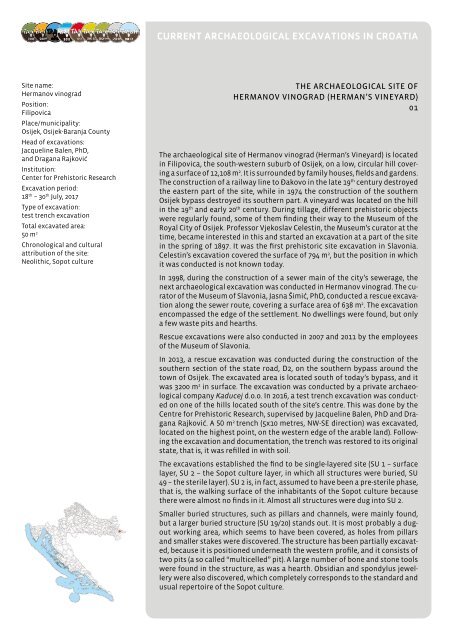AMZ_TAIUH_2017_ prijevodi na engleski
Create successful ePaper yourself
Turn your PDF publications into a flip-book with our unique Google optimized e-Paper software.
CURRENT ARCHAEOLOGICAL EXCAVATIONS IN CROATIA<br />
Site <strong>na</strong>me:<br />
Hermanov vinograd<br />
Position:<br />
Filipovica<br />
Place/municipality:<br />
Osijek, Osijek-Baranja County<br />
Head of excavations:<br />
Jacqueline Balen, PhD,<br />
and Draga<strong>na</strong> Rajković<br />
Institution:<br />
Center for Prehistoric Research<br />
Excavation period:<br />
18 th – 30 th July, <strong>2017</strong><br />
Type of excavation:<br />
test trench excavation<br />
Total excavated area:<br />
50 m 2<br />
Chronological and cultural<br />
attribution of the site:<br />
Neolithic, Sopot culture<br />
THE ARCHAEOLOGICAL SITE OF<br />
HERMANOV VINOGRAD (HERMAN’S VINEYARD)<br />
01<br />
The archaeological site of Hermanov vinograd (Herman’s Vineyard) is located<br />
in Filipovica, the south-western suburb of Osijek, on a low, circular hill covering<br />
a surface of 12,108 m 2 . It is surrounded by family houses, fields and gardens.<br />
The construction of a railway line to Đakovo in the late 19 th century destroyed<br />
the eastern part of the site, while in 1974 the construction of the southern<br />
Osijek bypass destroyed its southern part. A vineyard was located on the hill<br />
in the 19 th and early 20 th century. During tillage, different prehistoric objects<br />
were regularly found, some of them finding their way to the Museum of the<br />
Royal City of Osijek. Professor Vjekoslav Celestin, the Museum’s curator at the<br />
time, became interested in this and started an excavation at a part of the site<br />
in the spring of 1897. It was the first prehistoric site excavation in Slavonia.<br />
Celestin’s excavation covered the surface of 794 m 2 , but the position in which<br />
it was conducted is not known today.<br />
In 1998, during the construction of a sewer main of the city’s sewerage, the<br />
next archaeological excavation was conducted in Hermanov vinograd. The curator<br />
of the Museum of Slavonia, Jas<strong>na</strong> Šimić, PhD, conducted a rescue excavation<br />
along the sewer route, covering a surface area of 638 m 2 . The excavation<br />
encompassed the edge of the settlement. No dwellings were found, but only<br />
a few waste pits and hearths.<br />
Rescue excavations were also conducted in 2007 and 2011 by the employees<br />
of the Museum of Slavonia.<br />
In 2013, a rescue excavation was conducted during the construction of the<br />
southern section of the state road, D2, on the southern bypass around the<br />
town of Osijek. The excavated area is located south of today’s bypass, and it<br />
was 3200 m 2 in surface. The excavation was conducted by a private archaeological<br />
company Kaducej d.o.o. In 2016, a test trench excavation was conducted<br />
on one of the hills located south of the site’s centre. This was done by the<br />
Centre for Prehistoric Research, supervised by Jacqueline Balen, PhD and Draga<strong>na</strong><br />
Rajković. A 50 m 2 trench (5x10 metres, NW-SE direction) was excavated,<br />
located on the highest point, on the western edge of the arable land). Following<br />
the excavation and documentation, the trench was restored to its origi<strong>na</strong>l<br />
state, that is, it was refilled in with soil.<br />
The excavations established the find to be single-layered site (SU 1 – surface<br />
layer, SU 2 – the Sopot culture layer, in which all structures were buried, SU<br />
49 – the sterile layer). SU 2 is, in fact, assumed to have been a pre-sterile phase,<br />
that is, the walking surface of the inhabitants of the Sopot culture because<br />
there were almost no finds in it. Almost all structures were dug into SU 2.<br />
Smaller buried structures, such as pillars and channels, were mainly found,<br />
but a larger buried structure (SU 19/20) stands out. It is most probably a dugout<br />
working area, which seems to have been covered, as holes from pillars<br />
and smaller stakes were discovered. The structure has been partially excavated,<br />
because it is positioned underneath the western profile, and it consists of<br />
two pits (a so called “multicelled” pit). A large number of bone and stone tools<br />
were found in the structure, as was a hearth. Obsidian and spondylus jewellery<br />
were also discovered, which completely corresponds to the standard and<br />
usual repertoire of the Sopot culture.


